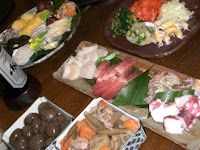Tuesday, 8 January 2008
Monday, 7 January 2008
Saturday, 5 January 2008
New Year decorations
We can see some of the New Year lucky items everywhere this time of the year.
Kadomatsu
Kadomatsu is a pair of pine tree decoration displayed on the gate or entrance of most of Japanese houses and buildings from the end of a year through 7th of January. It is thought Oshogatsu time is over around 7th.
Kadomatsu is a pair of pine tree decoration displayed on the gate or entrance of most of Japanese houses and buildings from the end of a year through 7th of January. It is thought Oshogatsu time is over around 7th.

Kagamimochi
Kagamimochi is made from rice cake, and looks like a Snowman. Displayed on Tokonoma (display place in tatami room) or Kamidana (altar in house) from the end of the year through the day of Kagamibiraki (braking Kagamimochi to eat). Kagamibiraki is on 11th of January in Tokyo area, but I think its custom is different in each area.

Friday, 4 January 2008
Shabushabu
Gorgeous food keeps on coming in Oshogatsu. Now is the Shabushabu time!
Put the donabe (special earthen pot) on the centre of the table, and boil vegetables, seafood and beef in it by one own. Dip in gomadare (sesame sauce) or ponzu (citrus sauce) as one likes to taste. Beef for Shabushabu: One of the unique points of Japanese food is to slice meat very thin.
Beef for Shabushabu: One of the unique points of Japanese food is to slice meat very thin.

 Beef for Shabushabu: One of the unique points of Japanese food is to slice meat very thin.
Beef for Shabushabu: One of the unique points of Japanese food is to slice meat very thin.
Big crab!

Thursday, 3 January 2008
Osechi ryori : Traditional New Year food
It is custom that Japanese families get together in Oshogatsu (New Year) and enjoy osechi-ryori (traditional new year food) together.
We believe Osechi-ryori brings us good luck. Most of them are like pun related to its name or its shape. For instance, Kobu (Sea weed) stands for "Yorokobu" (delight) and Nimame (stewed beans) stands for "Mameni kurasu" (living healthy). Kazunoko (herring roe) is symbol of big family, and Kuri-kinton (steamed chestnuts mixed with sweet potato paste) is thought to make us rich because it looks like gold coin.
Osechi-ryori is full of superstition. We have no Kurikinton this year. My family cannot expect to be rich this year...

Basic items for New year food.
Nimame (stewed beans),Tatsukuri (roasted small fish) and Kazunoko (herring roe.)
Assorted lucky food.



Labels:
Home cooking,
Japanese tradition,
Seasonal delicacy,
Washoku
Wednesday, 2 January 2008
Hatsumoude
It is Japanese tradition that visiting a shrine or a temple at begining of a year. I went to a local shrine in my home town.
Tuesday, 1 January 2008
Temaki zushi ( sushi )
Temaki zushi is hand rolled Sushi. It is good for enjoying Sushi at home. They are fresh tuna and another fish. Prepare nori (seaweed) on the palm, put some vinegar rice and fish on it. Wrap and dip a little in soy sauce, and then taste! So nice!!


Subscribe to:
Comments (Atom)







